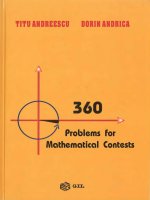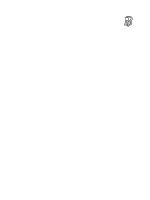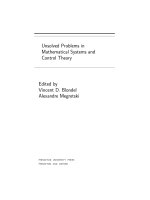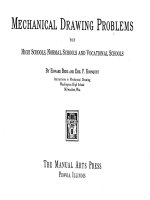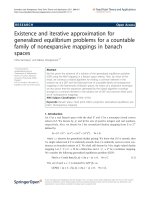Problems for Mathematical Reflections 6
Bạn đang xem bản rút gọn của tài liệu. Xem và tải ngay bản đầy đủ của tài liệu tại đây (89.71 KB, 4 trang )
Problems for Mathematical Reflections 6
Juniors
J31. Find the least perimeter of a right-angled triangle whose sides and
altitude are integers.
Proposed by Ivan Borsenco, University of Texas at Dallas
J32. Let a and b be real numbers such that
9a2 + 8ab + 7b2 ≤ 6.
Prove that 7a + 5b + 12ab ≤ 9.
Proposed by Dr. Titu Andreescu, University of Texas at Dallas
J33. Consider the sequence: 31, 331, 3331,... whose nth term has n 3s
followed by a 1. Prove that this sequence contains infinitely many composite
numbers.
Proposed by Wing Sit, University of Texas at Dallas
J34. Let ABC be a triangle and let I be its incenter. Prove that at least
one of IA, IB, IC is greater than or equal to the diameter of the incircle of
ABC.
Proposed by Magkos Athanasios, Kozani, Greece
J35. Prove that among any four positive integers greater than or equal to
1 there are two, say a and b, such that
√
(a2 − 1)(b2 − 1) + 1
3
≥
ab
2
Proposed by Dr. Titu Andreescu, University of Texas at Dallas
J36. Let a, b, c, d be integers such that gcd(a, b, c, d) = 1 and ad − bc = 0.
Prove that the greatest possible value of gcd(ax + by, cx + dy) over all pairs
(x, y) of relatively prime is |ad − bc|.
Proposed by Iurie Boreico, Moldova
Mathematical Reflections 6 (2006)
1
Seniors
S30. Prove that for all positive real numbers a, b, and c,
1
a+b+c
1
1
1
+
+
a+b b+c c+a
≥
1
1
+
ab + bc + ca 2(a2 + b2 + c2 )
Proposed by Pham Huu Duc, Australia
S31. Let ABC be a triangle and let P, Q, R be three points lying inside
ABC. Suppose quadrilaterals ABP Q, ACP R, BCQR are concyclic. Prove
that if the radical center of these circles is the incenter I of triangle ABC,
then the Euler line of the triangle P QR coincides with OI, where O is the
circumcenter of triangle ABC.
Proposed by Ivan Borsenco, University of Texas at Dallas
S33. Let a, b, c be nonnegative real numbers such that abc = 1. Prove that
1
1
1
4(ab + bc + ca)
+ 3
+ 3
+
≥ ab + bc + ca.
+ c) b (a + c) c (a + b) (a + b)(b + c)(a + c)
a3 (b
Proposed by Cezar Lupu, University of Bucharest, Romania
S34. Let ABC be an equilateral triangle and let P be a point on its
circumcircle. Find all positive integers n such that
P An + P B n + P C n
does not depend upon P .
Proposed by Oleg Mushkarov, Bulgarian Academy of Sciences, Sofia
S35. Let ABC be a triangle with the largest angle at A. On line AB
AB 3
consider the point D such that A lies between B and D and AD =
.
AC 2
3
√ BC
Prove that CD ≤ 3 ·
AC 2
Proposed by Dr. Titu Andreescu, University of Texas at Dallas
S36. Let P be a point in the plane of a triangle ABC, not lying on the lines
AB, BC, or CA. Denote by Ab , Ac the intersections of the parallels through
A to the lines P B, P C with the line BC. Define analogously Ba , Bc , Ca , Cb .
Prove that Ab , Ac , Ba , Bc , Ca , Cb lie on the same conic.
Proposed by Mihai Miculita, Oradea, Romania
Mathematical Reflections 6 (2006)
2
Undergraduate
U31. Find the minimum of the function f : R → R,
f (x) =
(x2 − x + 1)2
.
x6 − x3 + 1
Proposed by Dr. Titu Andreescu, University of Texas at Dallas
U32. Let a0 , a1 , . . . , an and b0 , b1 , · · · , bn be sequences of complex numbers.
Prove that
n
ak bk
Re
k=0
≤
1
3n + 2
n
|ak |2 +
k=0
9n2 + 6n + 2
2
n
|bk |2
k=0
Proposed by Jos´e Luis D´ıaz-Barrero, Barcelona, Spain
U33. Let n be a positive integer. Evaluate
∞
r=1
((n − 1)! + 1)r (2πi)r
·
r! · nr
n−1 n−1
(n − uv)
u=0 v=0
Proposed by Paul Stanford, University of Texas at Dallas
U34. Let f : [0, 1] → R be a continuous function with f (1) = 0. Prove
that there is a c ∈ (0, 1) such that
c
f (x)dx
f (c) =
0
Proposed by Cezar Lupu, University of Bucharest, Romania
U35. Find all linear maps f : Mn (C) → Mn (C) such that f (XY ) =
f (X)f (Y ) for all nilpotent matrices X and Y .
Proposed by Gabriel Dospinescu, Ecole Normale Superieure, Paris
U36. Let n be an even number greater than 2. Prove that if the symmetric
group Sn contains an element of order m, then GLn−2 (Z) contains an element
of order m.
Proposed by Jean-Charles Mathieux, Dakar University, S´en´egal
Mathematical Reflections 6 (2006)
3
Olympiad
O31. Let n is a positive integer. Prove that
n
k=0
n
k
n+k
k
n
2k
=
k=0
n
k
2
Proposed by Jean-Charles Mathieux, Dakar University, S´en´egal
O32. 18. Let a, b, c > 0. Prove that
4a2
a2
+
+ ab + 4b2
4b2
b2
+
+ bc + 4c2
4c2
c2
≤1
+ ca + 4a2
Proposed by Bin Zhao, University of Technology and Science, China
O33. 23. Let ABC be a triangle with cicrumcenter O and incenter I.
Consider a point M lying on the small arc BC. Prove that
AM + 2OI ≥ M B + M C ≥ M A − 2OI
Proposed by Hung Quang Tran, Ha Noi University, Vietnam
O34. Suppose that f ∈ Z[X] is a nonconstant monic polynomial such that
for infinitely many integers a, the polynomial f (X 2 +aX) is reducible in Q[X].
Does it follow that f is also reducible in Q[X]?
Proposed by Gabriel Dospinescu, Ecole Normale Superieure, Paris
O35. Let 0 < a < 1. Find, with proof, the greatest real number b0 such
that if b < b0 and (An ⊂ [0; 1])n∈N are finite unions of disjoint segments
with total length a, then there are two different i, j ∈ N such that Ai Aj
is a union of segments with total length at least b. Generalize this result to
numbers greater than 2: if k ∈ N find the least b0 such that whenever b < b0
and (An ⊂ [0; 1])n∈N are finite unions of disjoint segments with total length a,
then there are k different i1 , i2 , . . . , ik ∈ N such that Ai1 Ai2 . . . Aik is a
union of segments with total length at least b.
Proposed by Iurie Boreico, Moldova
O36. Let a1 , a2 , .., an and b1 , b2 , ..., bn be real numbers and let xij be the
number of indices k such that bk ≥ max(ai , aj ). Suppose that xij > 0 for any i
and j. Prove that we can find an even permutation f and an odd permutation
g such that
n x
if (i)
xig(i)
i=1
≥ n.
Proposed by Gabriel Dospinescu, Ecole Normale Superieure, Paris
Mathematical Reflections 6 (2006)
4
